|
How to Build a Proper Retaining Wall with Geogrid Fabric (stabilizing grid):
Retaining walls play a very important role in protecting landscapes from natural elements. It is essential that the wall is constructed correctly using proper material to ensure long term stability. If corners are cut and stabilizing grid is not used the wall can lose stability and fall, endangering people and damaging the landscape. When hiring professionals to do the work, always check their experience in this area of construction.
There are several reasons why retaining walls fail. The most common being inadequate drainage behind the wall. With poor drainage, moisture circulates, freezes and thaws which can happen on a daily basis during the colder seasons. Some northern states experience this more often during Spring months and then again in the fall. With a clay back-fill, during the evenings freeze sets in and then ice starts melting and working its way deeper into the surrounding area and pushes outward.
In other cases, the walls are being forced to hold back more soil than they can handle. While in most cases this is caused by novices who really do not know how to properly construct a retaining wall, there have also been cases with landscapers, who should know better, doing the same thing.
If a retaining wall is built too high there will be no reinforcement to handle the force. Customers are spending thousands of dollars to build these retaining walls and then thousands more to tear them down and start all over again. Anyone can go search online about failing retaining walls and discover just how disastrous the outcome can be.
How A Good Retaining Wall Is Constructed:
A retaining wall is actually quite straight forward and the materials needed are not overly expensive. In order to construct the wall properly the process will require some additional digging, backfilling and compacting. The upside, its very inexpensive compared to the cost of having to start all over again.
Sadly, many people, in an effort to save time and cost, do not know about stabilizing grid and whether they even need it in their construction. In many cases, they will hire contractors who truly do not understand how a retaining wall actually operates or when stabilizing grid is needed. The money they end out saving, gets spent when the wall needs to come down and they have to start over.
Retaining wall reinforcement grid (stabilizing grid) from SRW is a woven fabric that is extremely strong. This fabric has high tensile strength and is pinned between the layers of the retaining wall. This extends into the soil the wall is retaining and locks the block or stone wall together with the soil behind.
When Is Stabilizing Grid Needed:
Determining wether stabilizing grid is needed for your wall will depend on the wall building material as well as they type of soil to be retained. Clay soils, for example swell when moist and retain water and thus are the hardest to retain. When clay soil is to be retained, stabilizing grid is highly recommended.
The material used for a retaining wall matters a great deal, the more massive the material is, the less stabilizing grid will need to be used. For example, most six inch or eight inch wide split face limestone walls, stabilizing grid should be considered if the exposed height is over 24”.
stabilizing grid is most desirable for man made walls with a height of 36” to 48”, depending on the design and size. If there is a slope at the base of the wall stabilizing grid should also be taken into consideration.
Once you have a wall that is over 6 ft in height, constructed with 24”or wider limestone or similar blocks and very dense material, stabilizing grid should be used.
Building the Retaining Wall:
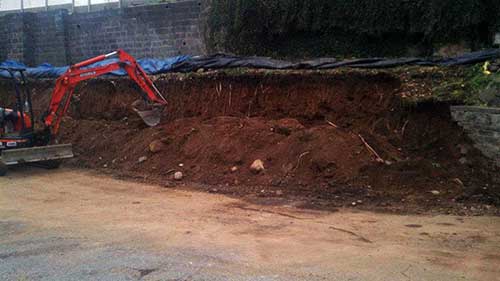
Step One:
First you must excavate the soil area for reinforcement. All existing soils should be removed in order to have maximum embedment (or enclosed area) length for the stabilizing grid. There should be a good level soil condition behind the wall units in order to place each stabilizing grid layer.
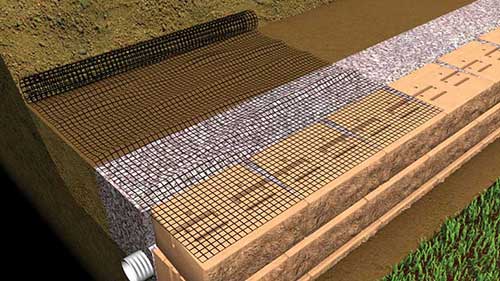
Step Two:
You need to cut the stabilizing landscape geogrid (rated for retaining walls) in sections from the roll to a specific length (the embedment depth). The stabilizing grid should be rolled in the direction from the wall toward the embankment. You should always check the manufacturer's specification for
biaxial or uniaxial stabilizing grid. In most cases, the stabilizing grid is rolled perpendicular to the face of the wall.
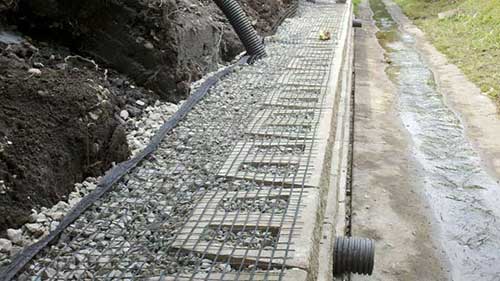
Step Three:
You have to hook the stabilizing grid over the Keystone pins to ensure a positive operating connect between the unit and the stabilizing grid. Always be sure the stabilizing grid is placed within one inch of the wall's face.
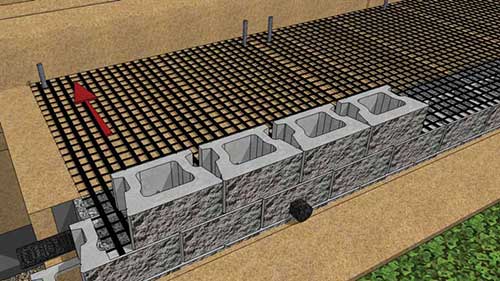
Step Four:
Secure the stabilizing grid by pulling the pinned stabilizing grid taut in order to eliminate any loose folds. Secure or stake the back edge of the grid before and during the back-filling and compaction. If desired, you can remove the stakes after the back-fill is in place. You can then place additional sections of grid, abutting each other, for a more continuous coverage for each layer.
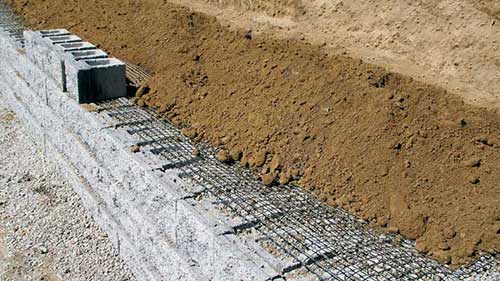
Step Five:
Finally, you will place back-fill over the grid in 8 inch lifts. Give a minimum of 6 inches reinforcement fill cover before driving any equipment over the grid. Stay away from driving or turning any vehicles directly over the grid, this could cause excessive damage.
Uniaxial Geogrid: Physical Characteristics and Common Uses
Uniaxial geogrid retaining wall mesh is one of those products that you’ve likely
benefitted from and probably haven’t realized it, either driven over or past
without even noticing. Uniaxial geogrid is used in many structural building
applications, but the question remains, though, what are uniaxial geogrids?
Uniaxial Geogrids are lattice grid fabrics made of high strength composites
or plastics such as high-density polyethylene or polypropylene. These strong
plastic punched sheets are used to reinforce paved roads, or structurally
support retaining walls.
Geogrids are commonly used all around the
world. They come in a few different styles and are made a handful of different
ways.
What Exactly is a Uniaxial Geogrid Material?
As
mentioned above, a geogrid can be made of very tightly woven polyester material
with a polymer’s protective coating.
The pattern of the geogrid is what
makes it uniaxial.
The uniaxial geogrid is stretched along the
longitudinal direction. This makes the stress only transfer along the
longitudinal axis. It also gives it a rectangle shape in the design.
Geogrid should not be confused with geotextiles, which are:
Where Is It Used?
Geogrids are used in many different
places that you drive by daily.
Geogrid Reinforcing Fabric is used on:
-
Steep walls, steep hillsides, retaining walls, and many
other vertical soil areas
-
If these areas are left unsupported, they could
potentially lead to a hillside erosion
-
When landslides happen, the best case scenario the road
is a little damaged; worst-case scenario, cars, houses, and lives could
sadly be taken in the slide.
-
They are also used as sheet anchors by being inserted
between geotextiles and geomembranes
-
As mentioned above:
-
Railroads can become damaged and fail if the earth
underneath gives way. This could lead to a derailment.
-
Trains are very heavy and will eventually wear down the
earth below them.
-
With the added support, the railway can last much longer
under the train’s heavyweight loads.
-
They are used on roads
-
Geogrids are also used in construction as an asphalt
overlay.
-
Adding a geogrid under the asphalt will help spread out
the weight of the asphalt across the dirt. (for an additional solution see
roadway grid cellular confinement products)
-
This helps support the ground from wearing down and
creating dips in the road when vehicles pass over
-
It contains the earth but also prevents the asphalt from
breaking away and settling into the dirt.
-
Utility companies
-
If you’ve ever driven past a scenery opening after
utility companies have removed a significant number of trees (the trees’
roots typically help keep the ground intact), you have more than likely
seen a geogrid.
-
After they are finished using the area, they are
responsible for putting a geogrid in place to help stabilize the earth
before adding new grass seed.
Geogrids work because they interlock with the fine material placed over
them locking the material in place and preventing the aggregate from moving
though the grid. This effectively creates a trapped solid layer that now
acts like a solid block of material rather than individual rocks or grains
of soil and provides stability to the layers underneath.
The
apertures allow the material to meet the covered soil, allowing the
materials to interlock with the geogrid holes. This provides confinement of
the underlying soil and safely prevents the soil/earth from shifting.
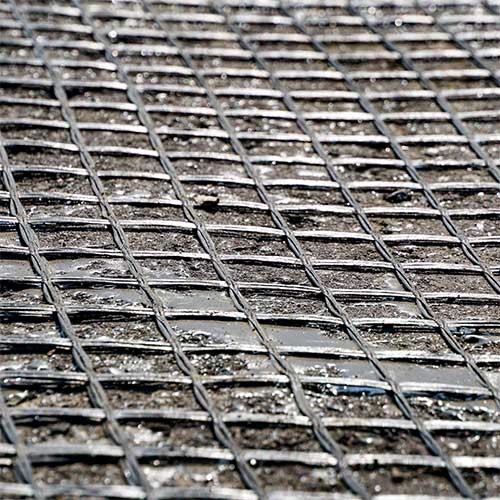 Advantages of Using Geogrid Mesh Advantages of Using Geogrid Mesh
There are many
advantages of using geogrids such as:
-
Geogrids are a fairly inexpensive construction material
compared to concrete retaining walls
-
They reduce the time it would take to finish the project
-
They will allow you to get better use out of your land by
supporting steep hills and making the land more useable
-
It may seem like a simple design and even feel flimsy to the
touch. This is intentional. Because of the flexibility, it can mold easily
to the ground, which can be very uneven.
-
During an earthquake, it is far less likely to break or
allow the land to give way.
-
They keep you safe from any debris falling when used as
retaining walls.
-
They don’t block the grass.
-
You won’t have to worry about seeing a hillside of only
dirt.
-
The grass will grow just fine (after grass seeds are put
down), leaving a nice sturdy hill.
Different Geogrid Patterns
There are
typically three different patterns used when speaking about geogrids.
These patterns are:
-
Uniaxial Geogrid – Also referred to as mono – oriented
geogrids.
-
As mentioned above, a uniaxial is stretched along the
longitudinal direction.
-
Simply put, the pattern is more of a long oval or
rectangle shape pattern.
-
This makes the stress transfer only along the axis, giving
it far higher strength in one direction over the other.
-
Biaxial Geogrid – Also known as bi-oriented geogrids. This
pattern is stretched along both longitudinal and transverse directions.
-
This design is more of a square shape.
-
The stress is equally transferred in both directions.
-
These are typically used in construction due to the
equal strength running along both axis’s
-
Triaxial Geogrid – This is a newer pattern in the geogrid
world.
-
This pattern also has the weight stretched in all directions
-
This pattern resembles diamonds or triangles.
Different Ways Geogrids are Manufactured
There are three different ways that geogrids are manufactured.
Depending
on the way it is manufactured will change the look and feel of the grid.
These are the different ways geogrids can be manufactured:
-
Woven Geogrid – These are as simple as they sound. These are
made from a very tightly woven polyester material with a protective coating
of polymer on it.
-
Bonded Geogrid – These are made by bonding at right angles.
Two or more sets of strands or other elements are typically used to form
this bond.
-
Extruded Geogrid – These geogrids are made of extruded
polymers. The uniaxial or biaxial polymers are stretched to create an
extruded integral structure. This pattern is far less flexible than other
types.
Final Thoughts
Geogrids are a simple
technology and largely have not changed over the years, but they are an elegant
solution for providing stability and longevity to civil structures such as
retaining walls and paved roads.
It is easy to see why they are so widely popular. They reduce the
amount of time and money you need to invest while helping you keep an area safer
or more structurally sound.
Sources:
https://www.texum.swiss/en/wikitex/glossary/uniaxial-geogrids
https://www.iricen.gov.in/ModelRoom/M5_Extruded%20Geogrid.html
https://happho.com/geogrids-manufacturing-process-applications-advantages/
https://www.westernliner.com/blog/what-is-a-geomembrane/
|